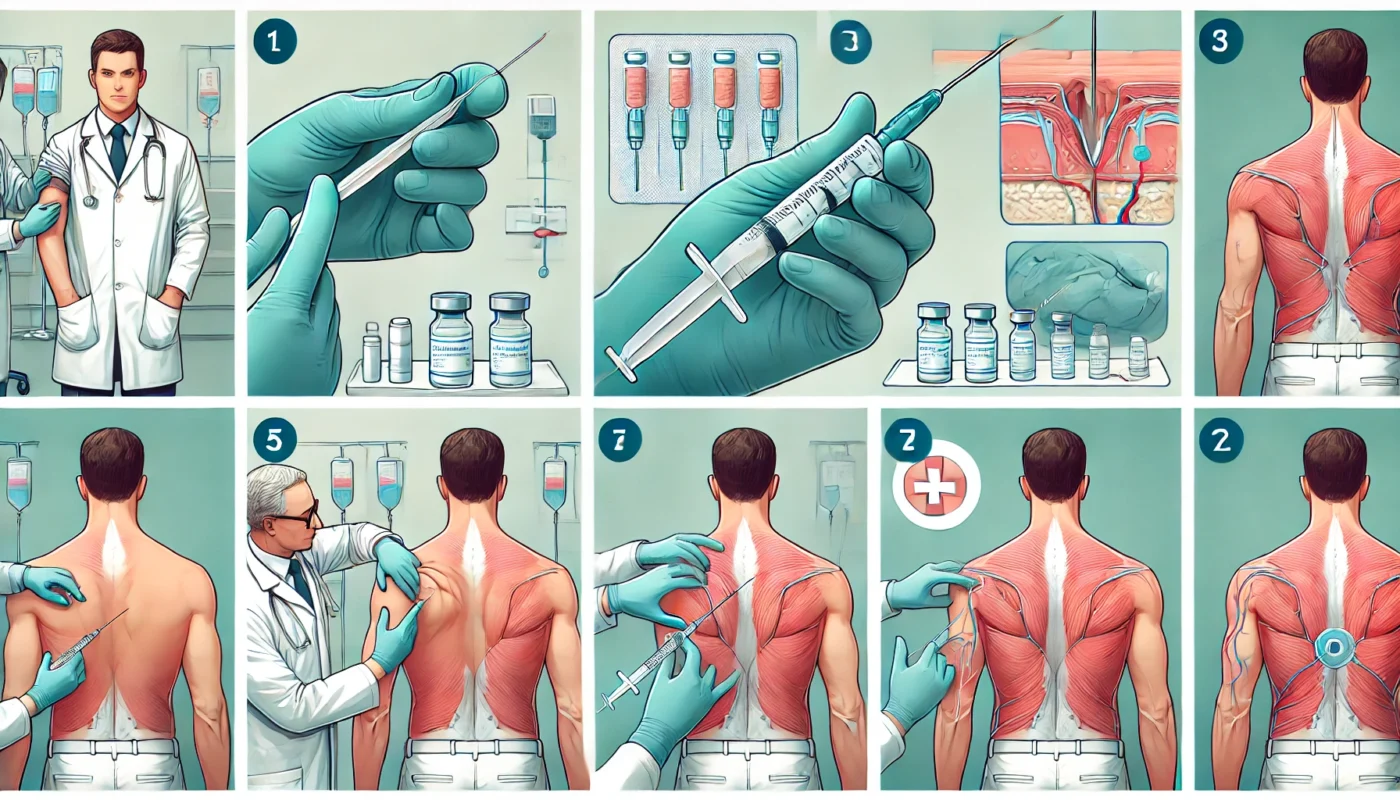In this article, we’ll delve into the essentials of administering intramuscular pain medications, discussing their benefits, potential risks, and step-by-step instructions to ensure safety and efficacy. We’ll also explore holistic strategies that can complement medical treatments, providing a comprehensive approach to pain management.
You may also like: Understanding Long-Term Pain Relief Options
Understanding Intramuscular Pain Medications
Intramuscular injections involve delivering medication directly into the muscle tissue, where it is absorbed into the bloodstream more rapidly than subcutaneous injections but slower than intravenous injections. This method is particularly effective for certain pain medications that require quick but sustained release.
Mechanism of Action
IM injections work by delivering the drug into the muscle fibers, where blood flow is abundant. The rich vascular supply allows for efficient absorption into the bloodstream, ensuring that the medication begins to take effect relatively quickly. This is particularly beneficial for medications that need to be delivered in a controlled, time-released manner.
Types of Pain Medications Used
There are various pain medications commonly administered via IM injection, including opioids, non-steroidal anti-inflammatory drugs (NSAIDs), and corticosteroids. Each type has its own mechanism and duration of action, making it important to choose the right medication based on the patient’s specific needs and medical history.
Duration and Onset of Action
The onset of action for IM injections typically ranges from 15 to 30 minutes, with effects lasting several hours, depending on the medication. This duration can make IM injections suitable for both immediate and extended pain management, providing relief without frequent dosing.
Benefits of IM Pain Medication
The primary advantage of IM injections lies in their ability to deliver medication quickly into the bloodstream without the need for a vein. This makes it a suitable option for patients who require fast-acting pain relief but lack intravenous access.
Additionally, IM injections can provide a longer duration of action compared to oral medications, making them an excellent choice for managing chronic pain conditions, postoperative pain, or severe acute pain episodes.
Accessibility and Convenience
IM injections offer a practical solution for patients who may have difficulty swallowing pills or have gastrointestinal issues that impede the absorption of oral medications. This method allows for pain management even when oral routes are not feasible.
Patient Compliance
For many patients, the predictable timing and duration of pain relief from IM injections can enhance compliance with their pain management regimen. Knowing that relief is imminent and sustained can improve adherence to prescribed treatment plans.
Risks and Considerations
While IM injections are generally safe, they are not without risks. Potential complications include infection, bleeding, and muscle damage if not administered correctly. It’s crucial to adhere to proper techniques and hygiene practices to minimize these risks.
Infection and Contamination
The risk of infection is present whenever the skin barrier is breached. Ensuring that all equipment is sterile and that the injection site is properly cleaned can significantly reduce this risk. Consistent use of aseptic techniques is paramount.
Pain and Discomfort at Injection Site
Some patients may experience discomfort or pain at the injection site. This can often be minimized by choosing the appropriate needle size and ensuring that the muscle is relaxed during the injection. Rotating injection sites can also help prevent localized irritation.

Allergic Reactions and Sensitivities
Patients may have allergies or sensitivities to certain medications or preservatives used in injectable forms. It is important to review patient history thoroughly and conduct any necessary allergy tests before administration.
Special Populations
Individuals with certain medical conditions, such as bleeding disorders or allergies to specific medications, should consult with a healthcare professional before proceeding with IM injections. Tailored approaches may be necessary for these populations to ensure safety.
Preparing for an Intramuscular Injection
Administering IM pain medication requires precision and care. Here’s a step-by-step guide to help ensure a safe and effective injection:
Step 1: Gather Your Supplies
Before administering an injection, ensure you have all necessary supplies at hand, including:
- The prescribed medication
- Sterile syringes and needles
- Alcohol swabs
- Cotton balls or gauze
- A sharps disposal container
Sterilization and Organization
Proper sterilization of all materials is crucial. Arrange your supplies in a clean, organized manner to prevent cross-contamination and ensure that each item is easily accessible during the injection process.
Step 2: Choose the Injection Site
Common sites for IM injections include the deltoid muscle of the upper arm, the vastus lateralis muscle of the thigh, and the ventrogluteal and dorsogluteal muscles of the buttocks. Each site has its own advantages, and the choice may depend on the patient’s size, age, and muscle mass.
Assessing Patient Anatomy
Assess the patient’s anatomy to select the most appropriate injection site. Consider factors such as muscle mass, fat distribution, and any previous complications or scar tissue from past injections.
Site Rotation and Record Keeping
Maintain a record of injection sites to ensure proper rotation. This practice helps prevent irritation, scar tissue formation, and ensures optimal absorption of the medication.
Step 3: Prepare the Injection
- Wash your hands thoroughly with soap and water.
- Use an alcohol swab to clean the top of the medication vial.
- Draw the prescribed dose into the syringe, ensuring there are no air bubbles.
- Change the needle if it has come into contact with anything other than the medication.
Ensuring Dosage Accuracy
Double-check the medication dosage to prevent errors. Use the correct syringe size and needle gauge for the specific medication and patient needs.
Step 4: Administer the Injection
- Clean the chosen injection site with an alcohol swab and let it dry.
- Hold the syringe like a dart, and insert the needle at a 90-degree angle to the skin.
- Aspirate by gently pulling back the plunger to ensure you’re not in a blood vessel. If you see blood, withdraw the needle and choose a new site.
- Slowly inject the medication, then withdraw the needle and apply pressure with a cotton ball or gauze.
Patient Comfort and Communication
Communicate with the patient throughout the process to alleviate anxiety and ensure they are comfortable. Explain each step to help them understand what to expect and address any concerns they may have.
Step 5: Dispose of the Needle Safely
Immediately dispose of the needle and syringe in a sharps container to prevent needlestick injuries and contamination.

Post-Injection Care
Monitor the injection site for any signs of adverse reactions, such as redness, swelling, or pain. Advise the patient on proper aftercare, including resting the muscle and observing for any unexpected symptoms.
Complementary Strategies for Pain Management
While IM pain medications can be highly effective, a holistic approach can enhance their benefits. Consider integrating the following strategies into your pain management plan:
Mind-Body Techniques
Practices such as meditation, deep breathing, and progressive muscle relaxation can help reduce the perception of pain and improve overall well-being.
Cognitive-Behavioral Approaches
Cognitive-behavioral therapy (CBT) can be effective in changing the negative thought patterns associated with chronic pain, helping patients develop coping strategies and improve mental resilience.
Physical Therapy and Exercise
Engaging in regular physical therapy or exercise tailored to your condition can strengthen muscles, improve flexibility, and reduce pain.
Customized Exercise Programs
Work with a physical therapist to create a personalized exercise program that addresses specific pain points and enhances mobility. This tailored approach can lead to more sustainable pain relief.
Nutritional Support
A balanced diet rich in anti-inflammatory foods, such as omega-3 fatty acids, fruits, and vegetables, can support overall health and potentially reduce pain levels.
Dietary Supplements and Hydration
Consider incorporating dietary supplements such as vitamin D or magnesium, which may play a role in pain modulation. Staying well-hydrated is also essential for maintaining overall health and supporting recovery.
Alternative Therapies
Acupuncture, massage therapy, and chiropractic care are alternative therapies that may complement traditional pain management approaches.
Integrating Multiple Therapies
Combining alternative therapies with conventional medical treatments can provide a synergistic effect, enhancing overall pain relief and improving quality of life.

Conclusion
Administering intramuscular pain medications requires a careful and informed approach to ensure maximum efficacy and safety. By understanding the benefits and risks, and following proper techniques, you can effectively manage pain through IM injections. Additionally, incorporating holistic strategies can provide a comprehensive approach to pain management, promoting overall health and well-being. As always, consult with healthcare professionals to tailor a pain management plan that best suits your individual needs and circumstances.
Further Reading:
PDQ Cancer Information Summaries [Internet].
Fentanyl IV/IM Formula (Sublimaze®)
intramuscular injections, pain management, pain medications, opioids, NSAIDs, corticosteroids, injection techniques, patient safety, holistic strategies, physical therapy, cognitive-behavioral therapy, alternative therapies, medication administration, healthcare professionals, post-injection care
Important Note: The information contained in this article is for general informational purposes only, and should not be construed as health or medical advice, nor is it intended to diagnose, prevent, treat, or cure any disease or health condition. Before embarking on any diet, fitness regimen, or program of nutritional supplementation, it is advisable to consult your healthcare professional in order to determine its safety and probable efficacy in terms of your individual state of health.
Regarding Nutritional Supplements Or Other Non-Prescription Health Products: If any nutritional supplements or other non-prescription health products are mentioned in the foregoing article, any claims or statements made about them have not been evaluated by the U.S. Food and Drug Administration, and such nutritional supplements or other health products are not intended to diagnose, treat, cure, or prevent any disease.

